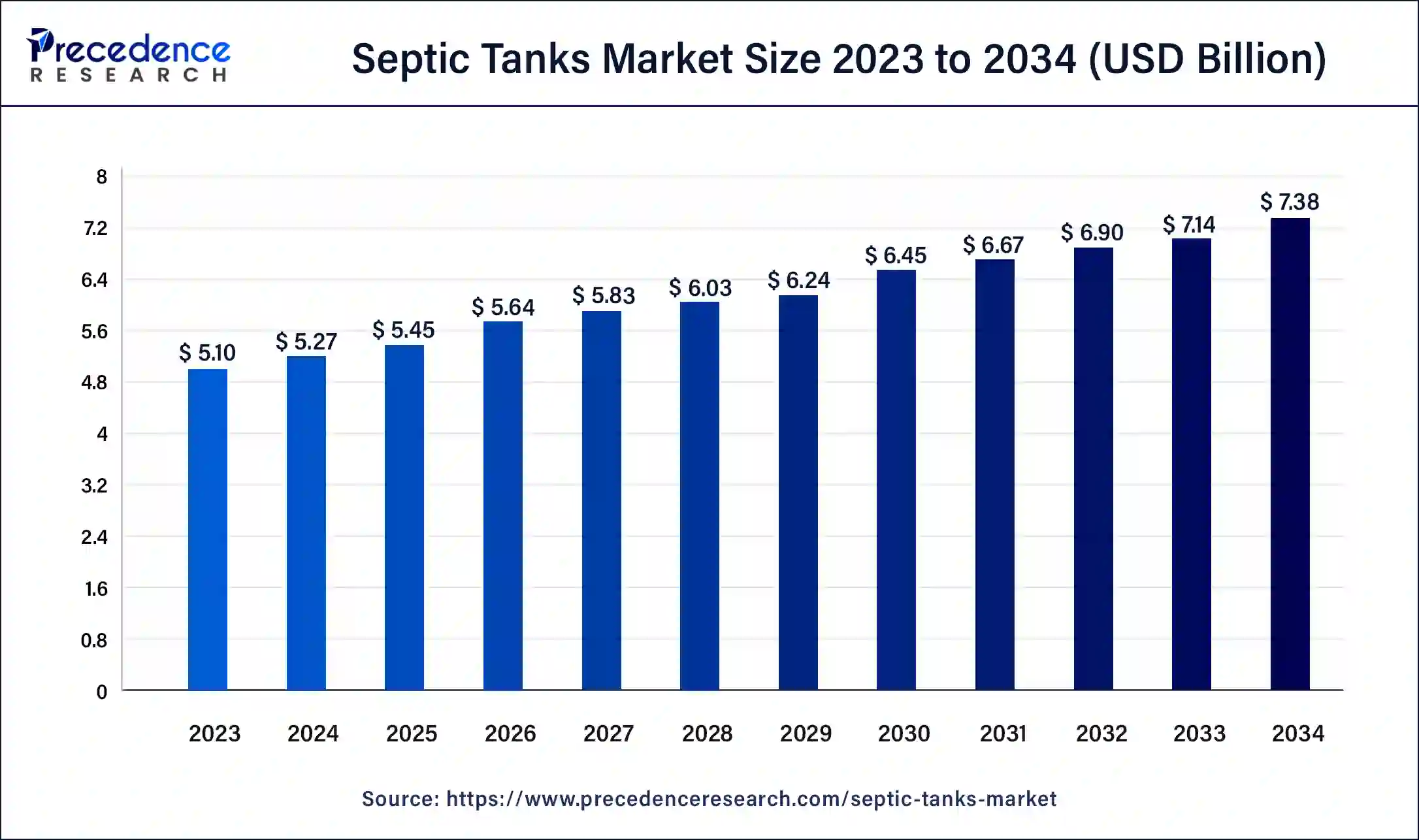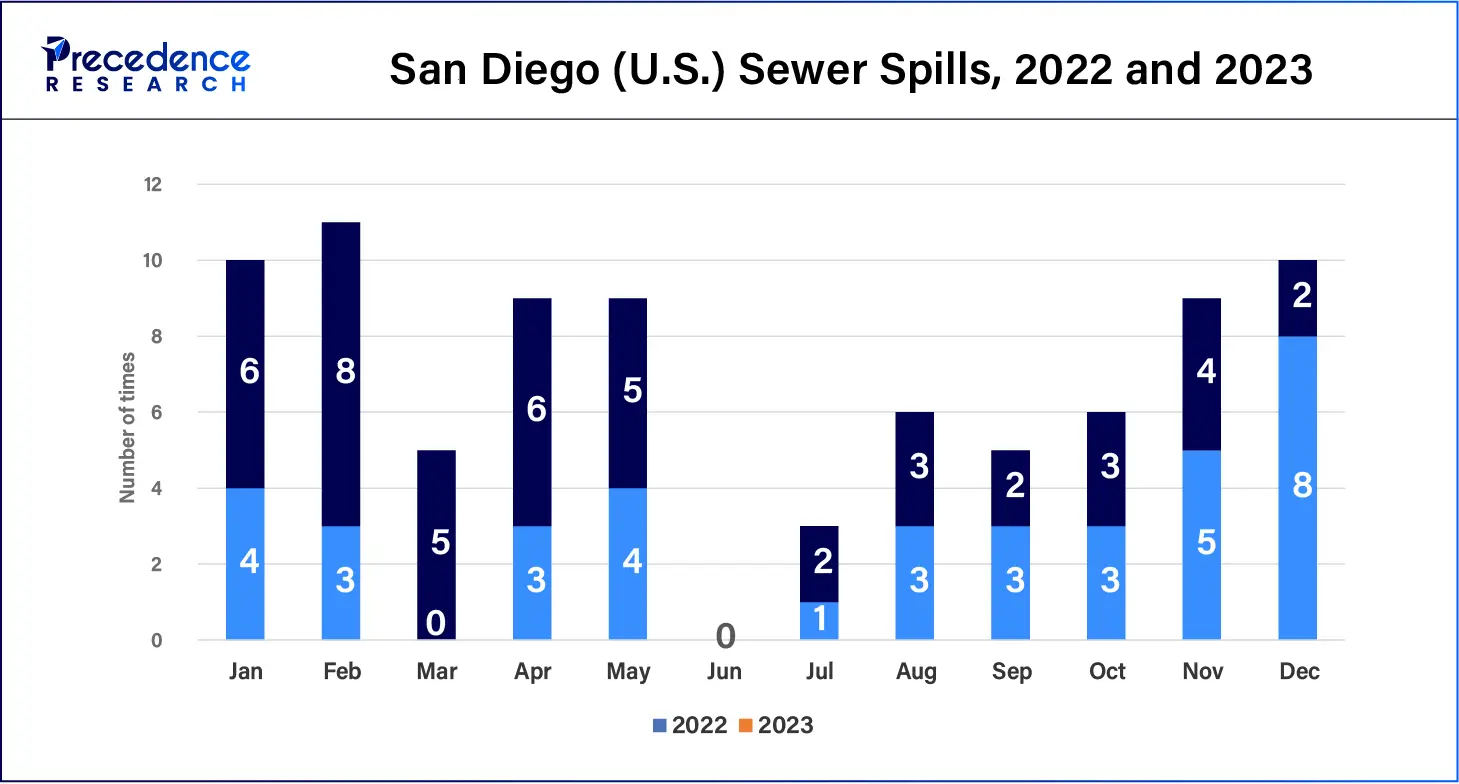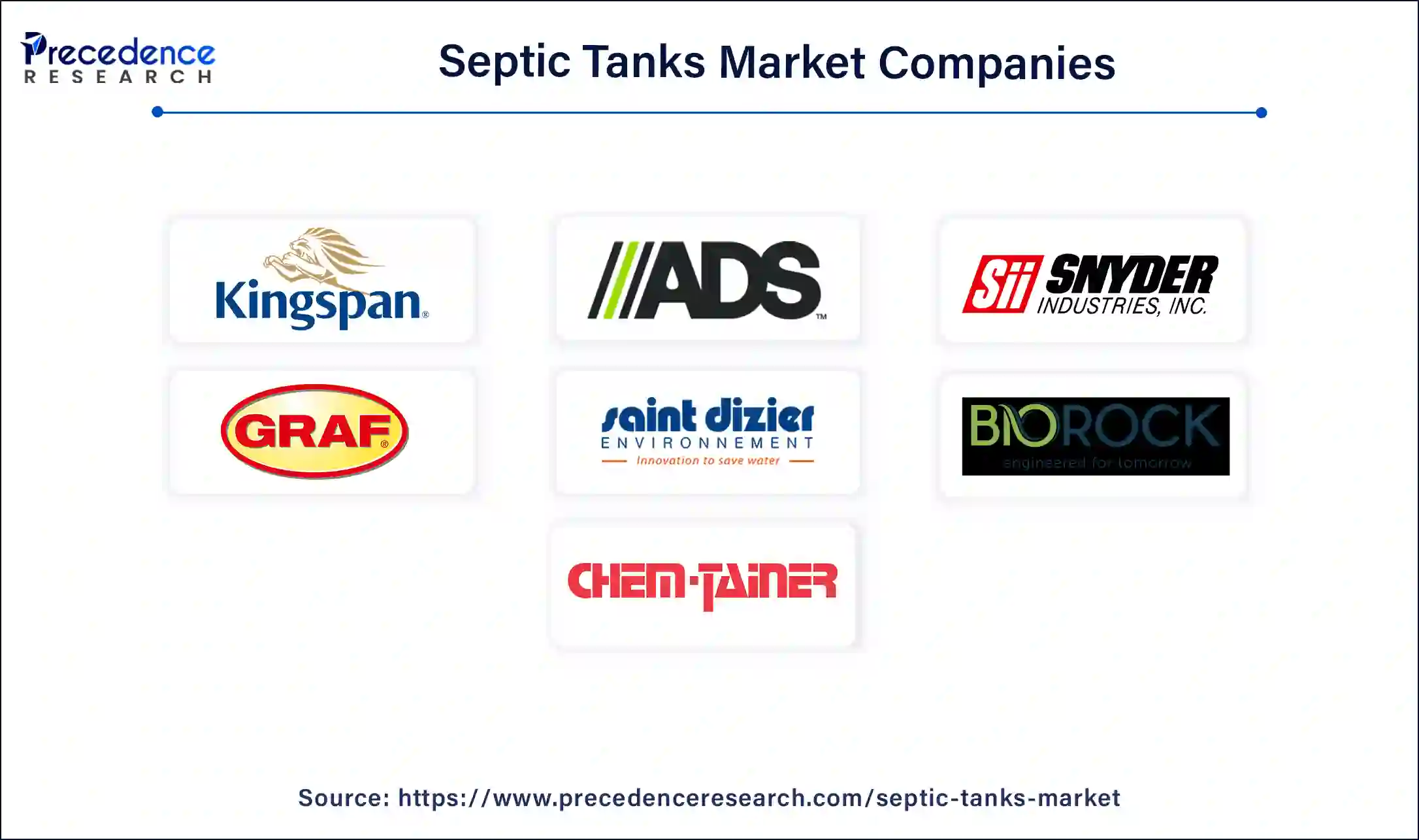The global septic tanks market size accounted for USD 5.27 billion in 2024, grew to USD 5.45 billion in 2025 and is expected to be worth around 7.38 billion by 2034, with a CAGR of 3.42% between 2024 and 2034.
The global septic tanks market size is worth around USD 5.27 billion in 2024 and is anticipated to reach around USD 7.38 billion by 2034, growing at a CAGR of 3.42% over the forecast period 2024 to 2034. The rising need to prevent contamination of the environment and underground water by treating human waste and separating solid and liquid in wastewater solutions drives the growth of the septic tanks market.

A septic tank is an underground biological decomposition and drainage tank for the water treatment process. With the help of natural processes and proven technology, septic tanks treat wastewater from household produce such as bathrooms, laundry, kitchens, and drains. The simple design of a septic tank is commonly made of fiberglass, concrete, or plastic. It is an on-site sewage facility (OSSF) where sewage treatment is performed at premises located in unsewered areas. Other similar types of water treatments that come under OSSF are aerated wastewater treatment, biofilter systems, composting toilets, and activated sludge systems. The OSSF protects public health and safety, maintains and enhances environmental quality, and maintains the community amenity.
How is AI Changing the Septic Tanks Market?
Artificial intelligence is capable of improving the energy efficiency of the septic tanks market. By implementing technologies such as Endobot and Swasth AI, which serve as pipeline diagnostic devices capable of detecting and eliminating contaminated water, wastages, and sewer spillage, which often goes unnoticed because of underground issues such as leaks, blockages, and tree roots.
| Report Coverage | Details |
| Market Size by 2034 | USD 7.38 Billion |
| Market Size in 2024 | USD 5.27 Billion |
| Market Growth Rate from 2024 to 2034 | CAGR of 3.42% |
| Largest Market | Asia Pacific |
| Base Year | 2023 |
| Forecast Period | 2024 to 2034 |
| Segments Covered | Material, Capacity, Application, and Regions |
| Regions Covered | North America, Europe, Asia-Pacific, Latin America and Middle East & Africa |
Purification of water
The installation of septic tanks ensures the safety of the environment and public health. The primary function of septic tanks is to treat the wastewater disposed from households and commercial settings. The process includes the removal of contaminants and the separation of harmful elements before releasing the water into the environment. It removes around 50% of the organic matter and suspended solid content in 2–4 days. It requires 0.5 to 1 year to digest the settled sludge. Meanwhile, the sludge is mineralized, and the volume is reduced. Septic tanks are designed with connecting chambers, which should be water-sealed to avoid underground infiltration. Imhoff tank is a variation of a septic tank that removes the suspended solids and controls the build-up of foul odor.
Maintenance and repair
The responsibility of the property owner is to maintain and repair a septic tank. Every 3-5 years, the septic tank must be pumped to prevent backups and overflows. A septic tank includes a T-shaped chamber which prevents the outlet of sludge and scum and moving into the drain field area. The tank must be pumped when the scum layer is within 6 inches of the bottom outlet, if the top sludge layer is within 12 inches of the outlet, or if there is more than 25% of liquid depth of sludge and scum. The only way to know this is to keep track of sludge and scum levels introduced by the septic professional.
Efficient use of water in the household improves the operation of the septic system and reduces the risk of malfunction. If there is overload in the septic tank it could lead to leaks or sewer spills.

Emerging technologies and eco-friendly innovations
Emerging technologies and eco-friendly innovations are expected to be witnessed in the septic tanks market. The innovations in the future trends are poised to enhance efficiency and increase the adoption of smart water technology and sustainability. Smart monitoring technologies such as IoT-based sensors and remote systems are expected to transform the way septic tanks are maintained. New sensor technologies will offer accurate and reliable monitoring results. The monitoring systems will perform in real-time, early detection of issues, alert predictive maintenance, and cost efficiency. The research and development team of wastewater systems has designed eco-friendly treatments such as microbial treatment and innovative filtration systems.
The plastic segment generated the biggest share of the septic tanks market in 2023. The increasing demand for a safe and easy-to-clean septic tank boosts the plastic material septic tank. The structure of a plastic septic tank is made of polyethylene, which has been used for the last 30 years in the industry. Plastic tanks are lightweight and easier to install than concrete tanks. They are less susceptible to water damage, corrosion-free caused by acidic soil, and less prone to cracks. Property owners with new or replacement projects prefer installing plastic tanks. The lifespan of a plastic tank is +30 years.
The concrete segment will show significant growth in the septic tanks market during the forecast period. Concrete tanks are the older septic tanks used. As people demanded lighter and more affordable alternatives, they replaced concrete tanks. Concrete septic tanks are preferred if the premises are in an area with a high ground water level, such as in the case of heavy rain, flooding, and property damage. They are naturally heavy, so they will not float out in case of high water levels. Concrete tanks have a longer durability of +40 years. However, due to the movement in the ground, the concrete tanks are more susceptible to damage.
The 1000-5000 litres segment recorded the highest share of the septic tanks market in 2023. The capacity of septic tanks depends upon factors such as daily wastewater, volume local regulation, and building occupancy. For a residential premise, the recommended septic tank is about 1000 gallons or 1.5 times the average total daily wastewater flow. The number of bedrooms in the house or the number of people estimates the suitable capacity of the tank.
The residential segment dominated the global septic tanks market share in 2023. Septic tanks are essential at household and work premises as they provide a safe and effective way of managing wastewater. They are much more beneficial than traditional sewage treatment; therefore, many property owners install septic tanks. Many people install septic tanks because they do not have access to the sewer system run by the city. A residential system ranges from 4, 5, 6, 8, 10, 15 & 30 people.
The commercial segment is anticipated to grow with the highest CAGR in the septic tanks market during the studied years. Wastewater removal treatment for commercial property such as offices, hotels, and warehouses, as well as safely disposing of the treated water into the environment. At commercial properties, a large volume of wastewater is produced. Therefore, a good-quality septic tank is mandatory. A commercial system can be used for 60, 90, 120 people, and so on. A routine check of inspection of water treatment at large landscapes is difficult, and to avoid any future problem, care, and maintenance check, a CCTV drain survey is implemented, which detects damages in the drainage systems. Early detection reduces the repair cost and efforts.
Asia Pacific dominated the septic tanks market in 2023. Asia Pacific is rapidly developing in urban wastewater management. In urban Asia, septic tanks are used by about 80% of the population. In Asian countries, governments prioritize infrastructure projects that promote economic activity, such as power plants and ports, over sewers, and water treatment systems. Across Asia, flush and pour-flush toilets are most commonly shifted into septic tanks. Implementing them in densely populated areas is easier and cheaper because of their practicality.
North America is estimated to host the fastest-growing septic tanks market during the forecast period of 2024-2034. In the U.S., more than one in five households use septic systems (decentralized) or small community cluster systems. Even then, only about one-quarter of homes had septic tanks, according to the U.S. Census Bureau. In California, only 10% of homes are on septic.

Segments Covered in the Report
By Material
By Capacity
By Application
By Geography
For inquiries regarding discounts, bulk purchases, or customization requests, please contact us at sales@precedenceresearch.com
No cookie-cutter, only authentic analysis – take the 1st step to become a Precedence Research client